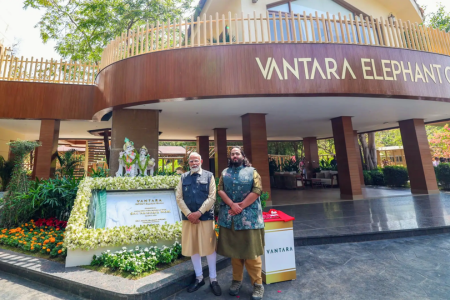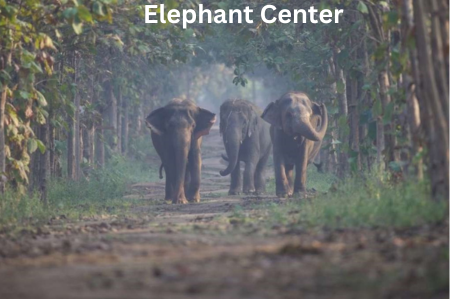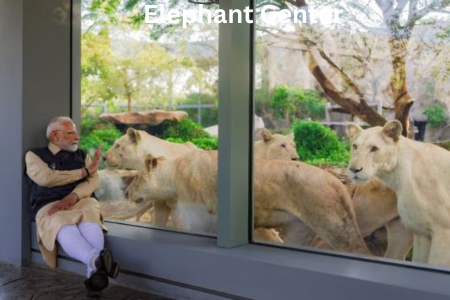India’s rich wildlife heritage is facing unprecedented challenges. From vanishing forests to rising human encroachment, the survival of many endangered species now hangs in the balance. But in the heart of Gujarat, a bold initiative is rewriting the future of conservation — Vantara, India’s largest private wildlife rescue and rehabilitation center.
Established by the Reliance Foundation in Jamnagar, Vantara (meaning “Forest”) is a one-of-a-kind sanctuary that combines modern veterinary care, sustainable habitat design, and a deep commitment to animal welfare. Home to thousands of rescued animals — from abused elephants to exotic birds — Vantara stands as a symbol of hope for India’s voiceless wildlife.
In this detailed 2025 guide, we’ll explore everything you need to know about Vantara: its location, significance, behind-the-scenes conservation efforts, controversies, and how you can experience this extraordinary sanctuary up close.
Also Read: Best 20 Hidden Places in India still Untouched
Table of Contents
What is VANTARA?
VANTARA is a one-of-its-kind wildlife rescue, rehabilitation, and conservation centre located in Jamnagar, Gujarat. The name “Vantara” is derived from Sanskrit, meaning “Star of the Forest.” It represents a bold and compassionate initiative aimed at protecting India’s most vulnerable animals.
Established by the Reliance Foundation, Vantara is designed to be a sanctuary for thousands of rescued, abandoned, or injured animals. From elephants and leopards to exotic birds and reptiles, the centre offers a safe and natural habitat for species that have suffered due to poaching, trafficking, abuse, or habitat loss.
What makes Vantara truly special is its integration of science, compassion, and scale. It is not just a rescue center but a large-scale, long-term commitment towards ethical animal welfare. With modern veterinary care, large enclosures replicating natural environments, and expert caregivers, Vantara sets a new benchmark for private wildlife rehabilitation efforts in India.
History & Background of Vantara
The story of Vantara begins with a vision — a vision to protect India’s vulnerable wildlife and restore hope to animals in distress. Conceived and developed by the Reliance Foundation, Vantara is the brainchild of Anant Ambani, who has long been passionate about animal welfare and conservation.
The idea for Vantara took shape after years of observing the alarming rise in wildlife-related challenges across India — from habitat destruction and climate change to poaching and illegal trade. There was a pressing need for a large-scale, scientifically managed center that could rescue, treat, and rehabilitate wild animals in a safe and nurturing environment.
In response to this growing crisis, Reliance established Vantara in Jamnagar, Gujarat, sprawling across a massive 3,500-acre green campus. Officially launched in March 2025, the center is equipped with state-of-the-art veterinary hospitals, nutrition labs, species-specific enclosures, and rehabilitation zones designed to mimic natural habitats.
Vantara’s mission goes beyond just rescue — it strives to create a sustainable future where both animals and ecosystems can thrive. Within a short span, it has already rescued and rehabilitated hundreds of animals, including elephants, leopards, birds, and reptiles from illegal captivity, trafficking rings, and human-wildlife conflict areas.
Location & Size of Vantara

Vantara is located within the Reliance Greens Campus in Jamnagar, Gujarat, one of the greenest corporate campuses in India. Surrounded by lush landscapes and a carefully restored natural ecosystem, this location was strategically chosen to provide a peaceful and secure environment for rescued wildlife.
Spread across an enormous 3,500 acres, Vantara is considered one of the largest zoo and wildlife rehabilitation centers in the world. Its vast area includes dense green zones, custom-designed enclosures, veterinary hospitals, and water bodies that simulate natural habitats for animals.
What sets Vantara apart is its sheer scale — the center is large enough to house and care for over 2,000 animals from different species at one time, with enough space to allow them to roam, heal, and thrive in semi-natural conditions. The layout has been carefully planned by wildlife experts, conservationists, and veterinary scientists to ensure every animal receives care tailored to its species and condition.
The remote yet well-connected location of Jamnagar also plays a vital role — it reduces stress for animals during transportation while ensuring easy access to modern medical facilities, logistics, and expert staff.
Wildlife Conservation at Vantara

At its core, Vantara is not just a rescue center — it’s a beacon of hope for India’s endangered wildlife. The facility is deeply committed to wildlife conservation, blending cutting-edge science with compassion to protect and preserve diverse animal species.
Vantara plays a critical role in safeguarding animals affected by habitat loss, poaching, illegal trade, and human-animal conflict. With a dedicated team of veterinarians, wildlife biologists, caregivers, and conservation experts, the center focuses on long-term strategies that ensure animals are not only healed but also rehabilitated into a life of dignity.
Some of the key conservation efforts at Vantara include:
- 🔬 Rescue & Rehabilitation: Injured, orphaned, and trafficked animals are provided emergency medical care, followed by species-specific rehabilitation plans.
- 🧬 Conservation Breeding Programs: Endangered species are bred in safe, regulated environments to help increase population numbers ethically.
- 🌱 Habitat Restoration: Vantara has created natural, enriched enclosures that mimic wild ecosystems, allowing animals to express natural behavior.
- 📚 Research & Education: The facility supports ongoing research in veterinary science, animal behavior, and conservation biology to develop better wildlife management practices.
- 🌍 Collaborations with Forest Departments: Vantara works closely with state forest departments, NGOs, and international organizations to support wildlife rescue missions across India.
Through these efforts, Vantara is not only saving lives — it’s building a sustainable model for private-sector-driven wildlife conservation in India.
Facilities & Features of Vantara

Vantara stands as a world-class model for wildlife care, thanks to its state-of-the-art infrastructure and thoughtfully designed features. Every facility at Vantara has been created to meet the unique medical, emotional, and behavioral needs of rescued animals, ensuring they recover in a safe and nurturing environment.
Here are some of the standout facilities and features that make Vantara truly exceptional:
🏥 Advanced Veterinary Hospital
Vantara houses one of the largest and most advanced wildlife veterinary hospitals in the world. Equipped with modern surgical theaters, diagnostic labs, CT scanners, and quarantine wards, the hospital provides 24/7 emergency care and treatment for injured or sick animals.
🧪 Nutrition and Recovery Labs
Customized diet and nutrition plans are created for each animal based on species, age, and health conditions. Specialized recovery labs ensure that animals receive the right balance of nutrients for faster rehabilitation and long-term health.
🌿 Naturalistic Enclosures
Unlike traditional zoos, Vantara features species-specific enclosures that mimic natural habitats like grasslands, wetlands, forests, and hilly terrain. These spaces allow animals to behave naturally and reduce stress during their healing process.
🐘 Dedicated Zones for Large Animals
Special enclosures have been built for elephants, big cats, and large herbivores. These zones are enriched with mud baths, water pools, shade shelters, and open roaming areas to support both physical recovery and mental well-being.
📹 Real-Time Monitoring System
To ensure the best possible care, all enclosures are monitored with CCTV cameras and sensors. This helps the caretakers track animal movement, feeding patterns, and behavior around the clock.
👨⚕️ Expert Staff & International Collaboration
Vantara is managed by a highly skilled team of veterinarians, zoologists, and wildlife caregivers, many of whom have international experience. The center also partners with global conservation organizations for training and knowledge exchange.
With these world-class facilities, Vantara has set a new benchmark for animal rehabilitation in India — one that combines compassion, technology, and global standards to give every rescued animal a second chance at life.
How is Vantara Helping in Wildlife Rehabilitation
Vantara is transforming the way India approaches wildlife rehabilitation. More than just a shelter, it acts as a comprehensive healing and recovery ecosystem for animals that have suffered due to human-animal conflicts, illegal trade, habitat loss, and natural disasters.
Here’s how Vantara is actively making a difference in wildlife rehabilitation:
🩺 Immediate Medical Care
When animals are rescued from critical situations—such as injury, poaching, or illegal captivity—they are brought to Vantara’s advanced veterinary facility. Here, trained veterinarians and caregivers provide urgent medical treatment, perform surgeries if needed, and stabilize the animals before beginning long-term rehabilitation.
🧘 Species-Specific Rehabilitation Plans
Each animal receives a customized rehabilitation plan tailored to its species, age, physical condition, and behavioral needs. This may include controlled exercise, physiotherapy, dietary support, and behavioral enrichment, ensuring a holistic recovery process.
🏞️ Stress-Free Recovery Environment
Unlike cramped or artificial enclosures, Vantara provides open, naturalistic habitats that replicate the animals’ native environment. These enriched enclosures help reduce stress and anxiety, which are common among rescued wildlife.
🐾 Rewilding & Soft Release Programs
For species that can eventually return to the wild, Vantara runs rewilding programs. Animals are gradually trained to regain their natural instincts—like hunting, foraging, and navigating terrain—before being released into protected areas in collaboration with forest departments.
🤝 Rescue Missions Across India
Vantara works hand-in-hand with state wildlife departments and NGOs to carry out rescue missions across India. From remote forests to urban conflict zones, their rescue teams are equipped to handle a wide range of wildlife emergencies.
📊 Monitoring & Post-Care
Even after recovery, animals are monitored for health and behavioral progress. For released animals, Vantara uses tracking devices and periodic health assessments to ensure they adapt well in the wild.
By focusing on compassionate care, structured rehabilitation, and science-backed recovery, Vantara is redefining wildlife welfare in India — offering rescued animals not just survival, but a dignified second chance at life.
How to Visit Vantara?
Although Vantara is primarily a wildlife rescue and rehabilitation centre — not a traditional zoo — visiting is possible for those who seek permission in advance. Here’s how you can plan your trip:
1. ✅ Permission Is Mandatory
- The centre is not open for unrestricted public visits. Visitors must apply online via the official Vantara website or go through the Reliance Foundation, providing details like group size and purpose (e.g., research, education, or wildlife enthusiasts)
- After reviewing, Vantara issues formal permission. Not all requests are guaranteed — priority is given to educational, research, and conservation-based visits
2. 🕘 Visiting Hours
- Tentatively, the centre operates between 9 AM and 5 PM, though exact timings are communicated upon approval .
- Visits are usually scheduled by appointment to ensure minimal disturbance to the animals.
3. 🎟️ Entry Fee & Booking
- Currently, there is no standard entry fee listed publicly — Vantara is still in controlled-access mode.
- Some sources indicate future intentions of paid guided experiences (₹300–700), including educational tours and safari-style viewing .
- Booking would likely be online via official channels, with time-slot selection, visitor details, and e-payment — similar to other wildlife centres.
4. 🧳 What to Expect During a Visit
- Guided Access Only: Visitors are escorted through meaningful habitats like the elephant care centre, bird aviaries, and reptile zones.
- Photography Guidelines: Cameras may be allowed, but flash photography is often restricted to avoid animal distress
- Behavioral Protocols: Quiet observation is encouraged. Carry no plastic, loud devices, or flashlights, and adhere to staff instructions .
5. 🗓️ Best Time to Visit
- The ideal visiting window is October to February, when Jamnagar’s cooler weather enhances both visitor comfort and animal activity
- Avoid peak summer (March–June) due to Gujarat’s intense heat.
How to Reach Vantara?
Vantara is located in the Reliance Greens Campus, near Motikhavdi, on the outskirts of Jamnagar, Gujarat. Here’s a detailed guide to get you there smoothly:
✈️ By Air
- The nearest airport is Jamnagar Airport (JGA), just 20–30 km away.
- Daily flights connect Jamnagar with Mumbai, Delhi, and Ahmedabad.
- From the airport, you can take a taxi (₹800–1,200) or a pre-arranged shuttle service for approved visitors.
🚆 By Train
- Jamnagar Junction (JAM) is well linked to major cities like Mumbai and Delhi via express trains
- Journey times: approx. 12 hrs from Mumbai, 18 hrs from Delhi .
- From the station, Vantara is about a 30–40 minute taxi ride (~₹150–200)
🚗 By Road
- The site lies off NH-27 / NH-947, well-connected to cities like Ahmedabad (≈300 km, 5 hrs), Rajkot (≈150 km).
- You can drive, hire a private cab, or take a bus to Jamnagar, then a local taxi to Vantara.
Pro Travel Tips
- Prefer early morning arrival (9 AM–10 AM) to enjoy the animals when they are most active.
- Coordinate with Vantara staff if using their shuttle service to avoid last-minute hassles.
- Since the centre is in a quiet zone, GPS may not be perfectly accurate—double-confirm directions before your visit.
Future Plans & Expansion of Vantara
Vantara is more than just a sprawling sanctuary — it is a dynamic, forward-looking initiative with ambitious plans to amplify its impact in wildlife conservation, scientific research, and educational outreach.
🌐 1. Immersive Digital Experience
In April 2025, Vantara launched a redesigned interactive website (vantara.in) featuring a 360° virtual tour, cohesive storytelling, and device-friendly navigation. This digital platform allows global audiences to explore the sanctuary’s habitats and rescue stories — reinforcing Vantara’s position as a world-class conservation leader.
📘 2. Encyclopaedia of Species & DNA Hub
Coming soon to the platform is a comprehensive “Encyclopaedia of Species”, featuring in-depth profiles on species—with details of habitats, diet, veterinary care, and rescue histories. Coupled with DNA analysis tools powered by the Vantara Dhirubhai Ambani Wildlife Research Lab, this will evolve into a go-to reference for conservationists and researchers.
🏛️ 3. Capacity Building & Zoo Partnerships
Anant Ambani has expressed goals to collaborate with the Zoo Authority of India and over 150 zoos nationwide — offering training, technical assistance, and infrastructure support. Vantara aims to elevate standards across India’s zoo network and serve as a blueprint for animal welfare practices.
🧬 4. Conservation Breeding & Reintroduction
Vantara is expanding its species-breeding programs, targeting critically endangered animals like Asiatic lions, rhinos, cheetahs, and even Spix’s macaws. As part of global conservation efforts, the center has helped reintroduce and restock populations within protected habitats.
🤝 5. Global Rescue Missions & International Collaborations
Already behind more than 2,000 rescue operations worldwide, Vantara plans to increase international missions and develop collaborations with institutions like IUCN and WWF. Through these alliances, Vantara hopes to influence wildlife rescue methodologies and policy dialogues globally .
🌱 6. Green Energy & Sustainability Integration
Aligned with Reliance’s commitment to achieve net‑zero carbon by 2035, Vantara will incorporate renewable energy, resource-efficient technologies, and eco‑friendly infrastructure across its facilities — making conservation a model for sustainable practice.
CONCLUSION
Vantara is more than just a wildlife rehabilitation centre – it is a pioneering effort in India’s conservation landscape. By providing rescue, medical care, and rehabilitation, it is playing a crucial role in protecting endangered species and combating illegal wildlife trade.
As India moves towards a more sustainable future, initiatives like Vantara will be instrumental in preserving biodiversity and ensuring the ethical treatment of animals. While it may not be open for tourism yet, its impact on wildlife conservation makes it a landmark project that deserves recognition and support.
If you’re passionate about wildlife conservation, keep an eye on Vantara’s future developments and support ethical conservation efforts!
FAQs About Vantara
1. Is Vantara open for tourists?
No, Vantara is primarily a rehabilitation centre and is not open for tourism.
2. How can I support Vantara?
You can support Vantara by spreading awareness, donating to wildlife conservation organizations, and avoiding unethical wildlife tourism.
3. Can researchers visit Vantara?
Yes, researchers and conservationists can apply for special access to study wildlife rehabilitation techniques.

1 thought on ““VANTARA – India’s Largest Wildlife Rescue & Rehabilitation Centre: Full Guide (2025)””
Comments are closed.